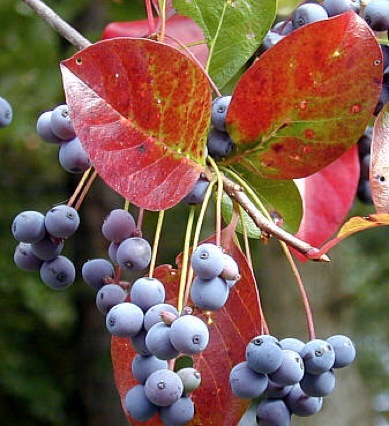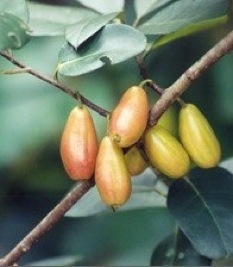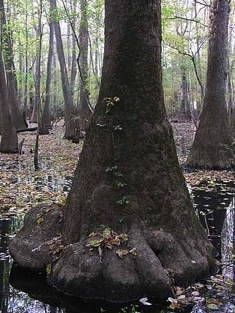Nyssus: Tart Botanical Tangles
The Black Tupelo is an old friend from around ponds where I grew up in Maine to around ponds (called lakes) here in Florida. (In Maine a lake must be 10 acres or larger to be called a lake, otherwise it is officially a pond. In Florida if you can’t throw a baseball across it, it is a lake. If you can it’s exclusive waterfront.)
Like many trees, the Black Tupelo, also called the Black Gum tree and the Sour Gum, barely makes it into the edible realm. The pulp of its fruit is technically edible, extremely sour and extremely bitter, which is why it is usually used in sweetened preserves. Its sibling, the Water Tupelo is likewise edible as is the Ogeechee Lime, another Tupelo. The juice of the latter is used like… lime juice.
Depending on who is doing the counting there are seven species in the genus, five in the North America, or nine to eleven total (and here you thought botany was a settled science void of monumental egos.) The most common one is Nyssa sylvatia, which is joined by Nyssa aquatica in the Southern states, or the Black Tupelo and the Water Tupelo respectively. While the Black Tupelos favor eastern North American then can grow quite well on the west coast of the U.S. The Ogeechee Lime (N. ogeche) however grows in a crescent from Massachusetts into the South, across the lower states, then up to southern Canada.
Most have horizontal or hanging branches and broad alternate leaves and are either male or female. The Black Tupelo, which has many 90-degree branches from the trunk, likes to have its feet in damp dirt. The Water Tupelo prefers to be in water. The Black Tupelo is deciduous, slow growing to 50′ tall and 30’ wide. Over time it forms a flat top with horizontal branches that may droop. Its leaves are generally elliptical and arranged alternately along the stems. The leaves are 3”-6” long and 1.5”-3” wide, and can have a wavy edge. Flowers are generally small and not notable. The female of the species has half-inch long dark blue-black fruit in the fall around when the leaves turn scarlet, purple, and yellow.
A variety of the Black Tupelo is called the Swamp Black Tupelo (N. sylvatica, var. biflora.) It grows in swamps along the east coast and in the Deep South. However some botanists think the swamp version is a different species and call it Nyssa biflora. And just to make that more complicated there is Nyssa ursine, the Bear Tupelo, which some think is a variety of N. biflora. So in this paragraph there might be one species and two variations, two species and one variation, or three species.
The Water Tupelo (N. aquatica), also called the Cotton Gum, or Swamp Gum, grows in — taah-daah — swamps of the southeastern and gulf coasts states and in the Mississippi River valley to southern Illinois. It grows in pure stands or in with bald cypress and other swamp trees. The Water Tupelo can reach 100 feet tall and its trunk is conspicuously enlarged at the base.
There is one aspect about the Water Tupelos range that prompts fascinating speculation. Its natural range comes down the east coast from the Carolinas, then diagonally across southern Georgia to the panhandle of Florida then west and up the Mississippi River valley. What’s intriguing about that is before there was a Central America (and thus no Gulf of Mexico say geologists) Florida was an island off Georgia. A channel — the Suwannee Channel — flowed north across what is now southern Georgia emptying in to the Atlantic. When the sea level dropped that low spot stayed wet but with fresh water and that is where one finds the Water Tupelo crossing Georgia into Florida. If that is a coincidence, it’s a good one.
The Ogeechee Lime (N. ogeche) is one of the rarer North American tupelo but has the largest range, from Cape Cod to the old South, across the southern US and then up the west coast to Washington State and southern Canada. It produces edible fruits. Often found in flooded sites in the southeastern U.S. the fruit is very sour and has been used as a lime substitute.
In the Dogwood family, Tupelos are also found in Mexico, China and Malaysia. They are famous for their monofloral (one flower) honey. Indeed the honey of the Ogeechee Lime doesn’t crystalize because of its high ratio of fructose to glucose. The center for Tupelo honey production is the Apalachicola River in the panhandle of Florida. Because of its rarity and singularity compared to other honeys it is a million-dollar business.
Tupelo wood, usually from the water tupelo, is pale yellow to light brown, fine-textured, strong, and hard to split when dry. It is used for crates and boxes, flooring, wooden utensils, and veneers. The fluted base of the Water Tupelo is especially favored by carvers. Birds that feed off Tupelo fruit include the American Robin, Swainson’s Thrush, Gray-cheeked Thrush, Hermit Thrush, Wood Thrush, Cardinal, Mockingbird, Blue Jay, Red-bellied Woodpecker, Yellow-bellied Sapsucker, Flicker, Pileated Woodpecker, Eastern Phoebe, Brown Thrasher, Eastern Bluebird, European Starling, Scarlet Tanager, Catbird, Cedar Waxwing, and the Crow.
The genus name, Nyssa (NISS-ah) refers to mythical water nymphs, read a fondness for wet places. Nysa was a water nymph and nurse to Bacchus. Sylvatia (sil-VAHT-ee-kuh) means of the woods. Aquatica (ah-KWA-tee-kuh) is living in water. Ogeche (oh-GEE-chee) is from Ogeechee, which is Creek for “our mother.” That species was first discovered by the white man — William Bartram — on the Ogeechee River, which is the longest river in Georgia.
Green Deane’s “Itemized” Plant Profile
IDENTIFICATION: Considerable variations. Except for the N. ursine, the tupelo is a tree with horizontal branches at right angles, leaves simple, alternation along the stem. Some in damp soil, others in water, fruit from round and dark blue to long and dark red to blue. Sour. Flowers small. Species ranged from 5 feet high to 100 feet high. N. ursine is basically a shrub of limited distribution in a few counties of western Florida.
TIME OF YEAR: Fruits usually in September or October
ENVIRONMENT: Damp soil or in water
METHOD OF PREPARATION: Berries can be chewed like gum (without the stone.) Used to make preserved. The Ogeechee Lime juice can be used like lime juice.





“N. ursine is basically a shrub of limited distribution in a few counties of western Florida.”
For the shrub Tupelo is it N. ursine or Nyssa ursina? Thank you.
My mother used a twig off this tree as a tooth brush when she was growing up in Alabama. She called it a black gum. I have one in my yard.
Do you have personal experience with the Ogeechee Lime fruit? I haven’t seen many descriptions of the fruit’s taste or cultivation on the internet. Is the fruit juicy and will it keep chilled or near frozen? If it’s juicy I imagine there could a niche market for ogeechees in place of lime or lemon slices in packaged or carryout food. The Citrus Guy sells them http://mckenzie-farms.com/fruits.htm and I might get one to see how it is.
I have an abundance of all the tupelo’s on my property including the ogeechee. Have never done anything with them. The lime is only about an inch long with a hard fibrous pith in it thereby lending very little juice or fruit per lime. I’m also told they produce a tupelo honey which goes for a pretty penny when sold. I don’t know if you’ve already gotten this information since your comment was three years ago, but thought I’d give my input seeing as how I have all these trees.
Do you have any more information on the ability of N.ogeche to grow and bloom in Maryland? I am interested in planting this excellent nectar producer on our farm for our bees, but can find little information about this species in the north, and whether it can be used as a nectar source in northern part of its range. Any info much appreciated.
Regarding Betty’s comment, my grandmother used the twigs for toothbrushes, too, when she was a child in Arkansas. The technique was to fray the end of the twig until you had a serviceable brush consisting of the separated wood fibers. They are common around my home town in NE Texas. We also call them blackgums.
In Cypress swamps in East Texas, there are swamp and water tupelos. Those we call tupelos, but the species that grows on drier sites we call blackgum. Blackgums have beautiful, vibrant red fall color that occurs before most other trees change color. In fact, there are almost always at least a few red leaves on them as early as July.
We have about 4 Nyssa ogeche treelings growing on our property near our beehives. I planted them deliberately to be near our bees in hopes of collecting some tupelo honey along with fruit honey from our orchard in the future.
If anyone has any ideas about where I can buy a few more Tupelo ogeches treelings, please let me know. Thanks.
Five longest rivers in the state of Georgia:
Chattahoochee River 430 miles
Flint River 344 miles
Savannah River 301 miles
Ogeechee River 294 miles
Coosa River 280 miles